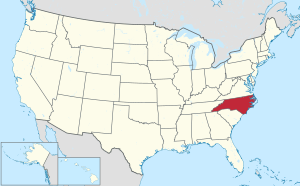Duplin County, North Carolina facts for kids
Quick facts for kids
Duplin County
|
|||||
|---|---|---|---|---|---|

Duplin County Courthouse in Kenansville
|
|||||
|
|||||

Location within the U.S. state of North Carolina
|
|||||
 North Carolina's location within the U.S. |
|||||
| Country | |||||
| State | |||||
| Founded | 1750 | ||||
| Named for | Thomas Hay, Viscount Dupplin | ||||
| Seat | Kenansville | ||||
| Largest community | Wallace | ||||
| Area | |||||
| • Total | 820.22 sq mi (2,124.4 km2) | ||||
| • Land | 814.72 sq mi (2,110.1 km2) | ||||
| • Water | 5.50 sq mi (14.2 km2) 0.67% | ||||
| Population
(2020)
|
|||||
| • Total | 48,715 | ||||
| • Estimate
(2023)
|
49,520 | ||||
| • Density | 59.80/sq mi (23.09/km2) | ||||
| Time zone | UTC−5 (Eastern) | ||||
| • Summer (DST) | UTC−4 (EDT) | ||||
| Congressional district | 3rd | ||||
Duplin County (/ˈduːp.lɪn/ DOOP-lin) is a county located in the U.S. state of North Carolina. As of the 2020 census, the population was 48,715. Its county seat is Kenansville.
Contents
History
The county was formed in 1750 from New Hanover County. It was named for Thomas Hay, Viscount Dupplin (later 9th Earl of Kinnoull), as he was known when he served on the Board of Trade and Plantations in England in the 1740s.
In 1784, the western part of Duplin County became Sampson County.
John Miller, a merchant in Duplin, was appointed as postmaster. In the 19th century, he migrated to Leon County in the panhandle of Florida, with other North Carolinians during the period of Indian Removal in the 1830s–1840s. There, he developed a successful cotton plantation. He called it Miccosukee Plantation, after one of the Seminole bands. (They are now a federally recognized tribe.)
Geography
According to the U.S. Census Bureau, the county has a total area of 820.22 square miles (2,124.4 km2), of which 814.72 square miles (2,110.1 km2) is land and 5.50 square miles (14.2 km2) (0.67%) is water.
State and local protected area
- Angola Bay Game Land (part)
- Cabin Lake County Park
Major water bodies
- Doctors Creek
- Goshen Swamp
- Groove Creek
- Island Creek
- Limestone Creek
- Little Limestone Creek
- Maxwell Creek
- Millers Creek
- Northeast Cape Fear River
- Stewards Creek
Adjacent counties
- Wayne County – north
- Lenoir County – northeast
- Jones County – east
- Onslow County – east
- Pender County – south
- Sampson County – west
Major highways
 I-40
I-40


 Future I-795
Future I-795 US 117
US 117


 US 117 Alt.
US 117 Alt.


 US 117 Conn.
US 117 Conn. US 421
US 421 NC 11
NC 11 NC 24
NC 24
 NC 24 Bus.
NC 24 Bus. NC 41
NC 41 NC 50
NC 50 NC 111
NC 111 NC 241
NC 241 NC 403
NC 403 NC 903
NC 903
Major infrastructure
- Duplin County Airport
- Eagles Nest Airport
- Henderson Field Airport
Demographics
| Historical population | |||
|---|---|---|---|
| Census | Pop. | %± | |
| 1790 | 5,663 | — | |
| 1800 | 6,796 | 20.0% | |
| 1810 | 7,863 | 15.7% | |
| 1820 | 9,744 | 23.9% | |
| 1830 | 11,291 | 15.9% | |
| 1840 | 11,182 | −1.0% | |
| 1850 | 13,514 | 20.9% | |
| 1860 | 15,784 | 16.8% | |
| 1870 | 15,542 | −1.5% | |
| 1880 | 18,773 | 20.8% | |
| 1890 | 18,690 | −0.4% | |
| 1900 | 22,405 | 19.9% | |
| 1910 | 25,442 | 13.6% | |
| 1920 | 30,223 | 18.8% | |
| 1930 | 35,103 | 16.1% | |
| 1940 | 39,739 | 13.2% | |
| 1950 | 41,074 | 3.4% | |
| 1960 | 40,270 | −2.0% | |
| 1970 | 38,015 | −5.6% | |
| 1980 | 40,952 | 7.7% | |
| 1990 | 39,995 | −2.3% | |
| 2000 | 49,063 | 22.7% | |
| 2010 | 58,505 | 19.2% | |
| 2020 | 48,715 | −16.7% | |
| 2023 (est.) | 49,520 | −15.4% | |
| U.S. Decennial Census 1790–1960 1900–1990 1990–2000 2010 2020 |
|||
2020 census
| Race | Number | Percentage |
|---|---|---|
| White (non-Hispanic) | 24,945 | 51.21% |
| Black or African American (non-Hispanic) | 11,437 | 23.48% |
| Native American | 154 | 0.32% |
| Asian | 155 | 0.32% |
| Pacific Islander | 4 | 0.01% |
| Other/Mixed | 1,207 | 2.48% |
| Hispanic or Latino | 10,813 | 22.2% |
As of the 2020 census, there were 48,715 people, 21,466 households, and 14,504 families residing in the county.
Economy
Duplin County is important in raising animals for food. It has more hogs than any other county in the United States—2.2 million in 1998, which is greater than the hog population of most states. The county is also the home to a major chicken and turkey industry.
Duplin County is also home to Duplin Winery, the oldest winery in North Carolina and the largest winery in the Southeast.
Education
Duplin County is home to James Sprunt Community College.
Communities
Towns
- Beulaville
- Calypso
- Faison (part)
- Greenevers
- Harrells (part)
- Kenansville (county seat)
- Magnolia
- Mount Olive (part)
- Rose Hill
- Teachey
- Wallace (largest community; parts within Pender County)
- Warsaw
Townships
- Albertson
- Cypress Creek
- Faison
- Glisson
- Island Creek
- Kenansville
- Limestone
- Magnolia
- Rockfish
- Rose Hill
- Smith
- Warsaw
- Wolfscrape
Census-designated places
- Bowdens
- Chinquapin
- Potters Hill
Unincorporated communities
Notable people
- Caleb Bradham (1867–1934), American pharmacist, best known as the inventor of the soft drink Pepsi. Bradham was born in Chinquapin.
- Benjamin F. Grady (1831–1914), U.S. congressman, author, teacher, farmer. Born near Sarecta on October 10, 1831. Taught mathematics and natural sciences at Austin College in Texas when the Civil War began. Superintendent of public instruction for Duplin County from 1881 to 1890. In 1891, he was elected for two terms as U.S. representative for North Carolina's 3rd congressional district.
- James Kenan (1740–1810), Colonial and state official, Revolutionary officer, founder of Kenansville, and sheriff of Duplin County. Kenan was born in Turkey, North Carolina, at his father's plantation, The Lilacs.
- Peter Weddick Moore (1859–1934), North Carolina educator and the first president of Elizabeth City State University. Moore was born near Faison, to Weddick and Alecy Thompson Moore, who were both enslaved African Americans.
- Charles S. Murphy (1909–1983), American attorney who served as the White House Counsel to U.S. President Harry S. Truman from 1950 to 1953, and during the Kennedy and Johnson administrations as Under Secretary of Agriculture, from 1960 to 1965; and chairman of the Civil Aeronautics Board from 1965 to 1968. Murphy was born on a farm in Wallace.
- Parker David Robbins (1834–1917), American soldier, legislator, inventor, and postmaster. Robbins was of African and Native American descent and considered a "free black." In 1877, he moved to Duplin County and established a cotton gin, sawmill, and built a steamboat. Robbins was born in Bertie County.
- Ruth Faison Shaw (1889–1969), American artist and educator who is credited with introducing finger painting into the United States education system. Shaw was born in Kenansville.
See also
 In Spanish: Condado de Duplin para niños
In Spanish: Condado de Duplin para niños





